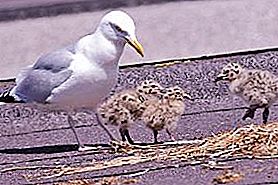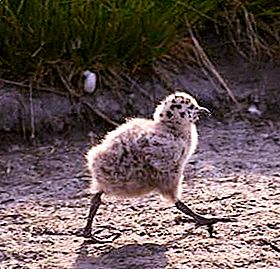Seagulls belong to the most numerous genus of birds from the gull family. They live in the open sea,

and inland waters. As a rule, gulls are birds of medium or large size. The plumage of them is usually white or gray, often there are black marks on the wings or head. A distinctive feature of these birds is the well-developed swimming membranes on their feet and the beak, which is slightly bent at the end.
Seagulls chicks appear well-haired and already with their eyes open. These spotted lumps are completely unlike their parents. For some time they are in the nest under their supervision. A few hours after the birth of the chicks of gulls begin to require food. For their parents, they remain unrecognizable just a few days after birth, then each of the parents will recognize their chick unmistakably. By the way, do you know the name of the gull chick? In the Dahl dictionary, a young gull (chick) is called a shepherd. But at Danilovsky’s, the savory is a hatched in the egg, but not yet hatched chick.

Seagulls are able to feed not only their chicks - they can take strangers, but only up to 14 days old. In nesting colonies, adoption most often occurs under certain conditions. For example, panic when a predator appears or caused by a person visiting. It can also happen due to adverse climatic conditions.
The most massive adoption occurs at Franklin's gulls, which nest in the swamps. They build their nests from reeds, and during the rise of water, many nests swim, because they can not gain a foothold. Franklin's young chicks often leave their nests at this time to swim. And each of them can climb into any nest where it will be accepted by adult birds into its brood.
But the gray gull, which reproduces in Chile in the sultry desert, has a slightly different situation. Adult birds stand above the nests and create a shadow with their bodies. Any gull chick can go to the nest, where he will be fed and sheltered from the sun. But if he is far from the nest, he will be attacked by adult gulls and even his parents.
I must say that seagulls are characterized by angry behavior. And their anger is always directed towards the chicks. This is especially true for males. They often attack chicks that come close to them or run past. During such attacks, the gulls chicks often die, and this would somehow justify themselves if they were later used as food. But no, this does not happen. So, males attack stray chicks only because they are descendants of other gulls. For example, in Klusha, intraspecific predation has a “domino effect”.

If someone steals a chick or an egg from a nest, then an angry male will steal an egg (or chick) from another pair and so on.
Colonial gulls have developed community care for their offspring. Such a phenomenon can occur spontaneously, due to the attack of predators. Chicks gather in large groups - nurseries, which are protected by adult birds. The formation of such a nursery helps gulls to protect their offspring from the attack of crows, rats and other predators. They can also be grouped if the colony is disturbed by a person. Some of the adult birds remain to guard the young, and the rest collectively drive away the alien or attack the predator from above.




